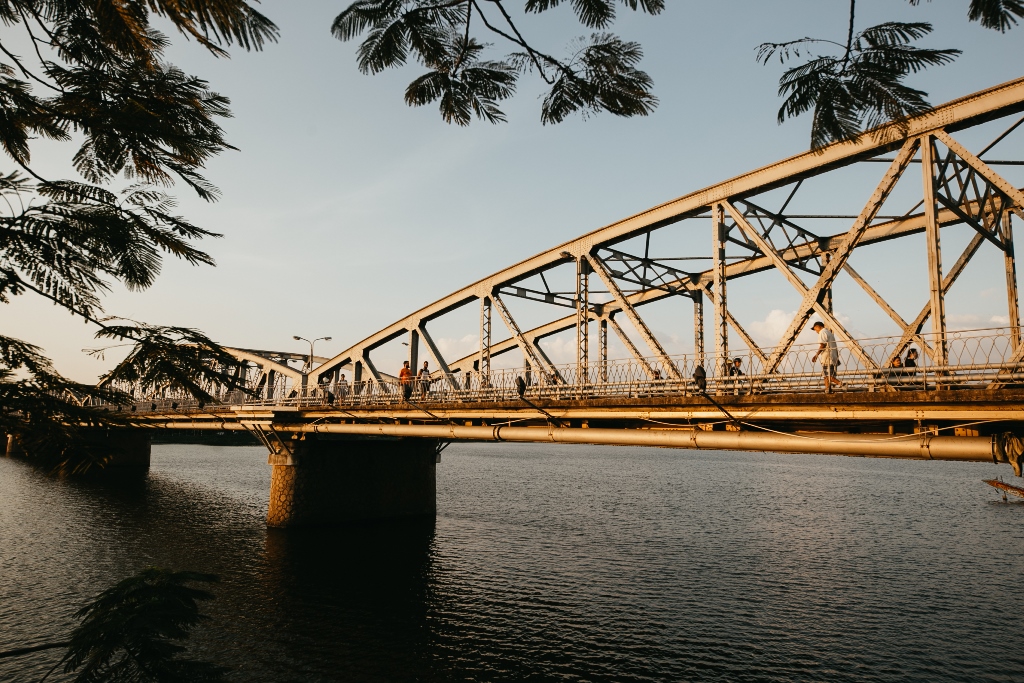
Truong Tien Bridge. Photo: Trung Phan
In order to diversify the activities, there was a tour put into operation called "Walking with Hue". The main facilities of the tour are on foot, with a 2-hour route, departing from Century Hotel, and with the program including visiting Pedagogical University, Truong Tien Bridge, Dong Ba Market and Thua Thien Historical Museum Hue, etc., it would help visitors experience interesting things, the beauty of the land and people of Hue, as well as the development process of Hue city in particular and Thua Thien Hue province in general.
Not to mention yet how the destinations in this tour are and whether they are special and attractive or not, I am really fascinated by the word "walking". It seems to touch the features of Hue cultural tourism. According to the usual explanation of the Vietnamese dictionary, "walking" is to walk with fast, hurried and seamless steps, in the style of "finished talking, immediately walking away". In the past, there was not much vehicles, people mainly go on foot and Hue people often have the habit of "walking".
About 40 years ago, I left my village for Hue to study at a boarding school in a foundation on Chi Lang street. I went to school in the morning, then self-studied and rested in the afternoon. My close friend, who lived in Quang Dien, and I often go wandering together, joking as exploring Hue. Our journey began from Gia Hoi quarter, where we were living. As it turned out, Gia Hoi quarter was the sacred land with many attractions, as the expression of people in tourism. Afterward, in a conversation with researcher Nguyen Dac Xuan, he listed the monuments in Gia Hoi that made me startled, uh huh, I had been there decades ago.

Dieu De pagoda. Photo: Trung Phan
According to Mr. Xuan, people could see in Gia Hoi quarter a series of mansions of lords and ladies, and the senior officials in the court of Hue, from the Palace of Honor of prime minister Nguyen Dinh Hoe, the Palace of Hưng Vuong family, the Palace of Lady Nhat, to the Palace of Grand Duke Vinh Tuong, of Ngoc Son Princess ... Here exist Dieu De pagoda, which was listed as one of the "twenty scenic spots of the ancient capital" by King Thieu Tri; Truong Xuan pagoda, which was built in the time of Nguyen lords; Thanh Binh ancestral house of Vietnamese opera sector, which was recognized as a national cultural relic ... The ancient town also has an only house with Indian architecture left in Hue. In such a density, it is not good to pompously going by vehicles. It would be the best for us to walk step by step and visit each place for enjoyment!
Adjacent to Gia Hoi is the Citadel with the king's palace, lords’ residences and many historical relics, which are suitable for someone to explore on foot. You can spend a half or a full day walking, wandering and having lunch in a restaurant, which is modest but very special; and there are lots of such restaurants in here.
I have traveled to many places in China. In general, tourism in many cities of this country is like Hue tourism with many historical and cultural sites and landscapes. It is also special to have to walk and walk a lot. Visiting the Chinese Palace or the Great Wall is no better way than walking to sweat and get tired. It is partly because the vehicles cannot serve tourists, but more importantly, it is worth watching the sites at everywhere that is dense and continuous.
Let consider Hue as a tourist space with lots of small spaces and specific tourist destinations. That's the way we build tours for small travel spaces like Gia Hoi.
There, with the not too far distance between destinations, it is the basis for the formation of walking tours with moderate number of visitors, about a few people to walk. Also, a careful observation shows that Hue is not yet so developed but it is loud and crowded enough. In this context, walking is also a way to organize tourism activities lightly, inexpensively and without any trouble, especially to contribute to the preservation of the fresh environment of Huong Ngu land.
By Dan Duy